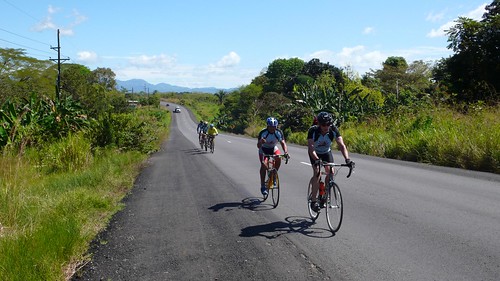
presented itself when we met Javier, the cyclist from Cerro Punta (before New Years). He told us of a group ride that he was going to participate in from David to Las Lajas and back (a century ride - 100 mi.) along the Pan-American highway. Our travel plans were again altered in order to join what we anticipated to be one of the highlights of our time in Panama. We were not disappointed. We traded in our over abundance of panniers and clutter for the company of the "Mountain Kings" bike team, 12 bikers from Cerro Punta and Volcan, including Craig, the cyclist who hosted us over New Years and Javier, whom we had met in Cerro Punta on his tractor.
There was no official group start to the paseo, but by 7:30 in the morning, David was already in our dust. We started a little later than most of the other cyclists, so the guys set a strong pace to begin with to catch up. Most of the Mountain Kings were mountian bikers and even though most of them were on mountain bikes with knobby tires, they set a pace of about 35 km/hr, that's a fast pace to keep up for a long time. So fast that after about 45 minutes Leah and I decided fall back and not try to keep up anymore. At first I thought we were going to finish the ride all alone, which made me a little disappointed, but we kept riding and soon Craig and a couple others dropped back to ride with us, which we really appreciated. Riding with the guys was a delight as they were really nice and riding in a group on the highway felt much safer than just Leah and I. Not a whole lot about the scenery along the ride really stuck out, there were some bluffs and also some pineapple plantations, a few hills, but nothing too bad. We still rode at a pretty good pace and reached the turn around point before we knew it. The first part of the ride wasn't without casualties however, a couple of the guys had bumped into eachother and taken a spill while a couple of others got some flat tires. At the turn around point most of the bikers who had left earlier in the morning were still there, but
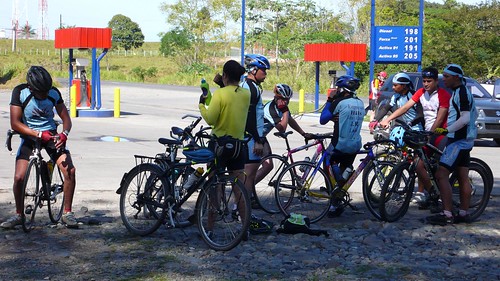 to my surprise most of them were loading up their bikes in the back of trucks and getting lifts back, it seemed that we were almost the only group that was doing the whole ride. After a about an hour's rest, some elbowing, joking, laughing and food we started the ride back, this time everyone at a pace that was more Leah's and my speed. It was on this return ride that we really were able to bond with the guys from the team and observe just how much they look out for their teammates. Craig was starting to cramp as well as suffer some effects of heat-stroke and fatigue due to the long distance and hotter than Louisianna hotsauce weather. He didn't feel much like eating or resting, two of the things he really needed to do, but the team took pains to encourage him to do so. When one of the guys got a flat tire we would all wait for him to patch it, and patch it again after his patch didn't work the first time. Leah and I were also really impressed with how strong every single one of the riders were. They weren't really accustomed to doing long distance as most of their races (mountain bike and road) are much shorter than 100 miles, but they all finished the ride like champions.
to my surprise most of them were loading up their bikes in the back of trucks and getting lifts back, it seemed that we were almost the only group that was doing the whole ride. After a about an hour's rest, some elbowing, joking, laughing and food we started the ride back, this time everyone at a pace that was more Leah's and my speed. It was on this return ride that we really were able to bond with the guys from the team and observe just how much they look out for their teammates. Craig was starting to cramp as well as suffer some effects of heat-stroke and fatigue due to the long distance and hotter than Louisianna hotsauce weather. He didn't feel much like eating or resting, two of the things he really needed to do, but the team took pains to encourage him to do so. When one of the guys got a flat tire we would all wait for him to patch it, and patch it again after his patch didn't work the first time. Leah and I were also really impressed with how strong every single one of the riders were. They weren't really accustomed to doing long distance as most of their races (mountain bike and road) are much shorter than 100 miles, but they all finished the ride like champions.
One of the guys really impressed me when his partner on their tandem mountain bike had to throw in the towel and catch a ride back on a truck. He pedaled the tandem solo the rest of the way, maybe 30 miles. When we got back to David, we went back to our hotel to shower and change while they went back to load up their bikes and get ready for their drive back to Volcan. Before they left, we met them outside of the hotel for one last goodbye and photo session. Craig told us how impressed they all were with Leah and how tough she was, keeping up with all of them (I was proud of her too). As we waved off our new friends with their bikes in the back of Craig's truck, the cab full, along with a couple of the guys lying in the back to hide from the cops and a car following with the trunk sagging due to the 7 guys in there we decided that we had just spent the day with the "Cool Runnings" team of biking in Panama. They didn't have the most sophisticated bikes or wealthy sponsors, but they sure were spirited and talented riders out to have fun. That was our last bike ride in Central America and although we may not have seen the most beautiful scenery it certainly was one of the most enjoyable and memorable.
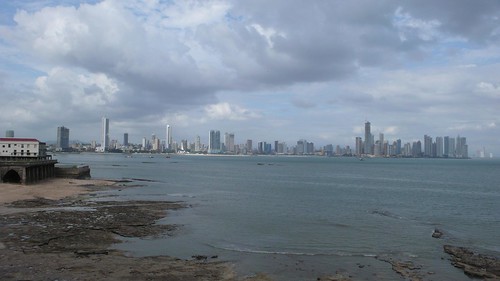
The next morning with surprisingly unstiff legs we left our bikes and most of our clutter in the hotel storage room and caught a bus to Panama City. We arrived around lunch time and wandered around the empty streets wondering where everyone was and why almost no businesses were open. We were getting kind of hungry but not being able to find any restaurants we stopped into a fancy hotel to get some directions. There they informed us that it was a national holiday (explaining the absence of people in the city) and pointed us in the direction of somewhere to eat as well as a youth hostel.
We checked into a hostel in the Cangrejo district of the city. This was our first time staying in a hostel on this trip. There we realized how much we took for granted the privacy and inexpensiveness of accomodations prior. The youth hostel did have its pluses, however. We met plenty of travelers from all over the world that all had their two cents on different places they had been, not just in Panama but the rest of the world. The most interesting person we met was Clara, a Japanese girl who had sailed with two other Japanese men from Vancouver, Canada. They were on their way through the Panama canal and up to New York where she would disembark and head back to Japan and her captain and co-captain would continue their journey around the world. She told us some great stories from her experience on the boat and shared her pictures with us. She also told us that for her captain, this trip has been his life-long dream and that one of his objectives for the trip is to share it with young people to broaden their horizons. She explained that he is always looking for others to join him for sections. Leah and I both looked at each other with the exact same expression in our faces, "Hmmmmm...that's something we'll have to think about."
Neither of us had much desire to spend a lot of time in Panama city as we aren't really city folks. We had our goal of seeing the Panama canal (a must see in Panama), Casco Viejo (the oldest part of the city) as well
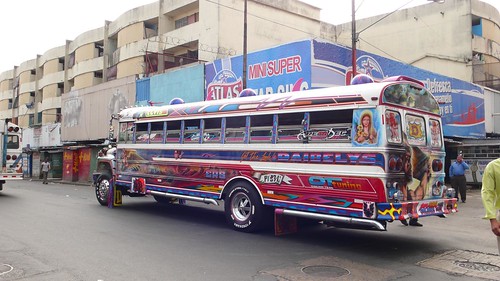
as just wandering the streets experiencing the hustle bustle against the backdrop of the most western city in Central
America. The skyline of Panama city definitely surprised me with is numerous existing skyscrapers as well as sky scrapers under construction. Part of the reason that the skyline is so impressive, however, is that it is spread out, there isn't really a central downtown area, therefore the buildings are kind of stretched out over a large area. If you look out into the bay off in the distance you see all the ships anchored, awaiting their turn to enter the locks, traverse the 80 kms across Panama and descend the locks on the East side and enter the Atlantic Ocean.
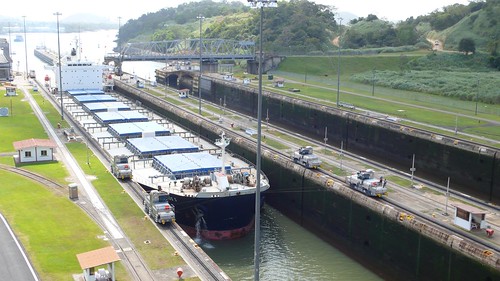
First thing in the moring
we caught a diablo rojo to the bus station. Diablo rojo (red devil) is what they call the buses in Panama City. Most of them are custom painted and decked out old school buses (think "Pimp My Ride", the TV show) the drivers drive like bats out of hell, but they can take you anywhere in the city for only a cuara (pronounced cwada - thats Panamanian for quarter (they use the American currency)). The visitor center is located at the Miraflores Locks and we arrived just in time to see the last ship go through. Although watching the ship enter the locks and rise isn't very exciting, for me, an engineer, it is neat to think about all the action, physics, and thought that made it happen. The visitor center was full of all kinds of
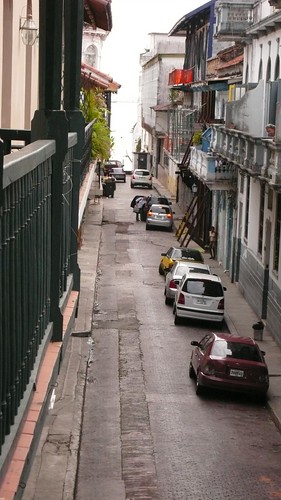 great information on the history of the canal, the mechanics of the canal, the international role of the canal, the environmental impact of the canal and future of the canal. I read every single information plaque in there and really enjoyed it. After the visiting the canal, we walked around Casco Viejo, where some of the oldest buildings in the city are located. It is full of Spanish colonial and French architecture much of which has been restored or at least partly restored. The bulkhead (out on the point) is the original seawall built to protect the city from pirates, namely Captain Morgan (no joke). It had a neat feeling walking the narrow cobble stone streets but it was also a little strange to know that only a few blocks away was the poorest and most dangerous part of Panama City, which we had driven through in a cab. People told us it was so dangerous there that the only people who go there or even take a bus through there are the people that live there. We walked back to the hostel through the city and it was much more lively then the ghost town it had been the day before. All the shops were open, the streets were full of loud, honking traffic, diablos rojos cruised the streets, and the markets were full of people and goods.
great information on the history of the canal, the mechanics of the canal, the international role of the canal, the environmental impact of the canal and future of the canal. I read every single information plaque in there and really enjoyed it. After the visiting the canal, we walked around Casco Viejo, where some of the oldest buildings in the city are located. It is full of Spanish colonial and French architecture much of which has been restored or at least partly restored. The bulkhead (out on the point) is the original seawall built to protect the city from pirates, namely Captain Morgan (no joke). It had a neat feeling walking the narrow cobble stone streets but it was also a little strange to know that only a few blocks away was the poorest and most dangerous part of Panama City, which we had driven through in a cab. People told us it was so dangerous there that the only people who go there or even take a bus through there are the people that live there. We walked back to the hostel through the city and it was much more lively then the ghost town it had been the day before. All the shops were open, the streets were full of loud, honking traffic, diablos rojos cruised the streets, and the markets were full of people and goods. 
By the time we reached the hostel a couple hours later, we were ready to rest our senses as well as leave the city the next morning and head somewhere a little quieter. The next place we headed was El Valle, a town set in the crater of a dormant volcano. Years ago, the volcano exploded with such force that it blew its enitre top off creating a crater. It eventually filled with water, but later the water eroded a canyon in the crater wall and the lake drained. The indigenous people were the first to move in and take advantage of the fertile soil on the valley floor. A road was built into the crater not so long ago and rich Panamanians and gringos started buying up the land and building second homes up there (BIG ones). It certainly was a beautiful area but we decided that we were more interested in meeting up with Marta and Alex Pinzon of Penonome whom we had met in Pedasi. After contacting them and making sure they actually had time to at least meet us for lunch or something, we left El Valle for Penonome.

We arrived in Penonome called Marta to let her know we were in town. We were about to get a hotel, but to our surprise she insisted on picking us up and taking us back to her house. She showed us excellent and totally unexpected hospitality by putting us up in her son Alex's room for the next two nights. Marta took us around Penonome and showed us the sights, the old part of the city, the monument that designated the geographical heart of Penonome and the suburbs. She was a great conversationalist and very gracious in her Spanish, speaking slowly and clearly for us as well as using simple vocabulary, making us feel quite confident to converse with her in Spanish. We spent the next day with Peter (the exchange student
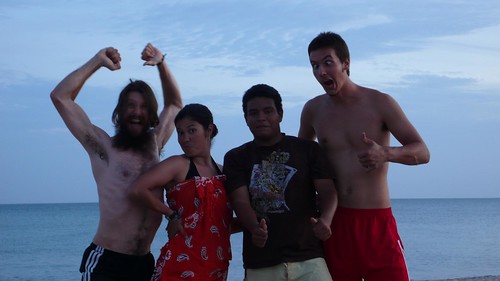
from Maryland) and Alexander (a local friend), at the beach not too far from Penonome. We tossed the frisbee around, swam in the bathwater temperature Pacific Ocean, told stories, passed the time with idle chitchat and watched the sunset. It was a really great day and nice to hang out with Peter and Alexander. The next morning it was time to go back to David so we said our goodbyes to Peter, Marta and Alex. Leah and I both hope that someday we are able to see the Pinzon family again, whether it be in the US or in Panama, they are great people and we consider ourselves very lucky to have met them.
We arrived in David and spent the rest of the day getting our bikes and all our stuff together and ready to

head back to Costa Rica (it actually didn't take much time and we just wandered around David taking in our last bit of Panama). In the morning we caught the direct bus from David to San Jose. We were a little worried at the border when we saw them opening everyone's luggage because our bags are a pain to open and close but when the agents saw our bags and we told them we were bike tourists they just waved us through, pretty convenient. The bus went up and over Cerro de la Muerte (Hill of the dead) which was about 2-3 hours of curvy, steep two lane road that took us into the clouds and mist. Our last two days were spent catching up with Enrique, watching the inauguration (Go Obama!), and boxing up the bikes. It was a bittersweet occasion to leave Central America.
Throughout our time here we experienced unimaginable hospitality, beauty, nature, and bliss, but also experienced the realities of poverty, greed, pollution, and survival. We leave with grateful hearts to the people we've met and for the priviledges we have and now appreciate. This experience has changed us in ways that we are unable to articulate (or even understand) at this point, but it will become evident in the future as we develop as people.

No comments:
Post a Comment